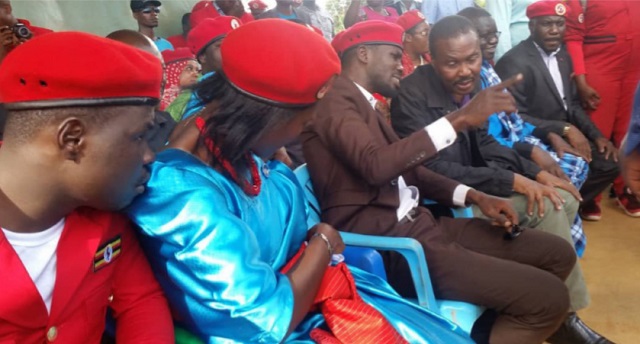
Fights within NRM
From that point, it became a wait and see affairs as voters stayed away from voting in the morning. Momentum appeared to increase as the day progressed but by the time voting closed at 4pm; it was a relief because most polling officials had been waiting without voters coming in.
In the end voter turnout was just 43% despite the high stakes campaign.
Many observers told The Independent that whether by design or not, the heavy military appears to have scared voters away from the polling booths.
According to many observers, the other reason for the low voter turnout was that although this election happened because Hoima district had been chopped into two almost equal halves, the district that retained the old name remains big and rural. It is bigger than most districts such as Jinja, Masaka or Tororo. Although this area retained the more urban areas, it is still more rural than most of Uganda, with very poor infrastructure. It is here that voters were expected to trek to 266 polling stations spread in 69 parishes over 17 sub-counties.
This is also Uganda’s oil territory and in some cases, the voting areas were new as voters had been moved to make way for oil production infrastructure such as roads. Now many of them were expected to walk long distances from polling stations. In Mparo, Kyabigambire, and Kitoba sub-counties, many villages were at least 2kms away from a polling station.
Then there was the politics of oil money and jobs, and shifting alliances. According to many commentators, this is a new Hoima, and the narrow vote margin between Businge and her challenger, Asinansi Nyakato is a sign of its new face. The opposition is gaining a foothold. The opposition candidate won 28,789 votes against the NRM candidate’s 33,301 votes. That is a difference of 4512 votes. President Museveni was unimpressed. In a statement after the election, he said he doubts the opposition actually got those votes.
“We are auditing the voting to discover the cheating which is characteristic of the opposition,” he wrote, “all this is partly, due to the weaknesses of the NRM.”
Museveni said the NRM in Hoima was divided, especially in Hoima town. He is right but the NRM divisions are nothing new. In 2010 the NRM in Hoima was split during the party primary contests that saw Kaahwa Tophas Byagiira defeat Beatrice Byenkya Nyakaisiki who was the incumbent woman MP. Byenkya threatened to tear up the NRM card and accused then Prime Minister Henry Kajura who is also the district NRM chairperson of unleashing ineligible voters to defeat her. Similar fights were seen within NRM in Hoima in 2005. The new thing is the emergence of the opposition.
In the last Hoima District Woman MP election, the winner and NRM candidate Tophace Byagira Kaahwa gathered 96,277 votes compared to a paltry 9,779 votes for the FDC candidate Rehema Nabisere. But there is more to the story because Harriet Businge, who has won this time, ran as an independent in 2016 following squabbles within her party; the NRM. In a sign of how deep the divisions were in NRM, Businge got 43,038 votes. There was also another independent candidate, Ruth Akoraebirungi who got just 1343 votes. That means that the two candidates allied to NRM in 2016, Kaahwa and Businge, scooped 93% of the vote in 2016.
One of the biggest misses of the Hoima election is that Businge and Nyakato were not had enough. The podiums at their rallies were jammed with many speakers – mainly men and from faraway Kampala.
The lost candidates
That was unfortunate because Businge and Nyakato are formidable politicians who pursue their passions with zest. It would have been interesting to see how Banyoro choose between two establishment candidates who happen to be for and against President Museveni’s government.
Nyakato was the perfect anti-Museveni candidate and appeared to be a god-send in a hostile region for the youthful wave of opposition led by Kyadondo East MP Robert Sentamu Kyagulanyi; the music superstar turned politician of People Power fame.
A graduate with a degree in social work, Nyakato has worked as a policy analyst in parliament and quit to become a fighter for the rights of her kingdom and community affected by oil and gas developments.
She ran for the Hoima Woman parliamentary seat in 2011 and lost to Byagira. Many expected her to try again in 2016 but she did not. The by-election possibly looked like too good a chance to miss.
She is a princess in the Bunyoro kingdom and she nurses grudges against the NRM government that are shared by many Banyoro. A true firebrand, Nyakato wants Bunyoro to get special allocations from oil money and has led protests and written petitions to parliament on these issues.
 The Independent Uganda: You get the Truth we Pay the Price
The Independent Uganda: You get the Truth we Pay the Price



If Andrew Mwenda’s take that “the NRM narrowly won the by-election for woman MP in Hoima district” basing on Harriet Businge’s 33,000 votes (54%) and FDC’s Asinansi Nyakato’s 29,000 votes (46%), then your conclusion that the main outcome of the by-election was that Museveni’s candidate, Harriet Businge had won, while Bobi Wine’s had failed is only apparently correct. Andrew Mwenda further indicates that “the outcome of the hoima election was a major setback for NRM, which has historically won Hoima with huge margins”. He further illustrates that “in 2006, the FDC candidate for Woman MP in Hoima got only 15% of the votes that the NRM candidate got; in 2011 only 10% and in 2016 25%. In this by election, the FDC candidate got 86% of the votes the NRM candidate got”. Woudn’t I be therefore justified to refute your earlier conclusion and say what the facts point to: the main outcome of this by-election was that Harriet Businge’s prime-sponsor lost while the Asinansi Nyakato’s principal “talisman” won?
“According to many election observers and politicians that The Independent spoke to, the opposition loss in Hoima was largely down to some well-known campaign issues; including that a charismatic campaign amounts to nothing if it cannot get voters into the voting booth. And it does not matter what blocks the voter’s path.”
ALL that has been said in your “analysis” boils down to that one paragraph and to the last sentence therein.
“And it does not matter what blocks the voter’s path.” And you can put that in CAPITALS.
Because the NRM/M7 did everything including throwing in the proverbial sink, to make sure that this , of all elections was “WON”.
Whatever else you say in this article is just a whitewash and justifying the unjustifiable and what everyone else , apart from yourself , can see.